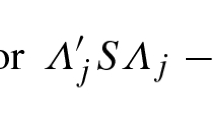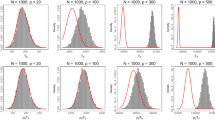Abstract
We propose an index for assessing the degree of factor simplicity in the context of principal components and exploratory factor analysis. The new index, which is called Loading Simplicity, is based on the idea that the communality of each variable should be related to few components, or factors, so that the loadings in each variable are either zero or as far from zero as possible. This index does not depend on the scale of the factors, and its maximum and minimum are only related to the degree of simplicity in the loading matrix. The aim of the index is to enable the degree of simplicity in loading matrices to be compared.
Similar content being viewed by others
References
Bentler, P.M. (1977). Factor simplicity index and transformations.Psychometrika, 42, 277–295.
Carroll, J.B. (1953). An analytical solution for approximating simple structure in factor analysis.Psychometrika, 18, 23–38.
Clarkson, D.B. & Jennrich, R.I. (1988) Quartic rotation criteria and algorithms.Psychometrika, 53, 251–259.
Cureton, E.E., & Mulaik, S. (1975). The weighted varimax rotation and the promax rotation.Psychometrika, 40, 183–195.
Hendrickson, A.E., & White, P.O. (1964). Promax: a quick method for rotation to oblique simple structure.British Journal of Statistical Psychology, 17, 65–70.
Kaiser, H.F. (1958). The varimax criterion for analytic rotation in factor analysis.Psychometrika, 23, 187–200.
Kaiser, H.F. (1974a). An index of factorial simplicity.Psychometrika, 39, 31–36.
Kaiser, H.F. (1974b). A note on the equamax criterion.Multivariate Behavioral Research, 9, 501–503.
Kiers, H. A. L. (1994). SIMPLIMAX: oblique rotation to an optimal target with simple structure.Psychometrika, 59, 567–579.
Lorenzo-Seva, U. (2000). The weighted oblimin rotation.Psychometrika, 65, 301–318.
Nevels, K. (1986). A direct solution for pairwise rotations in Kaiser's Varimax method.Psychometrika, 51, 327–329.
Saunders, D.R. (1962). Trans-varimax.American Psychology, 17, 395–395.
ten Berge, J.M.F. (1995). Suppressing permutations or rigid planar rotations: A remedy against nonoptimal varimax rotations.Psychometrika, 60, 437–446.
Thurstone, L.L. (1947).Multiple Factor Analysis. Chicago, IL: University of Chicago Press.
Tucker, L.R., Koopman, R.F., & Linn, R.L. (1969). Evaluation of factor analytic research procedures by means of simulated correlation matrices.Psychometrika, 34, 421–459.
Author information
Authors and Affiliations
Corresponding author
Additional information
The author would like to thank the review team for their insights and recommendations. This work was supported by a grant SEC2001-3821-C05-C02 from the Spanish Ministry of Science and Technology.
Rights and permissions
About this article
Cite this article
Lorenzo-Seva, U. A factor simplicity index. Psychometrika 68, 49–60 (2003). https://doi.org/10.1007/BF02296652
Received:
Revised:
Issue Date:
DOI: https://doi.org/10.1007/BF02296652




